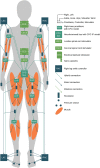Hormonal computing: a conceptual approach
- PMID: 37663143
- PMCID: PMC10469008
- DOI: 10.3389/fchem.2023.1232949
Hormonal computing: a conceptual approach
Abstract
This paper provides a conceptual roadmap for the use of hormonal bioinspired models in a broad range of AI, neuroengineering, or computational systems. The functional signaling nature of hormones provides an example of a reliable multidimensional information management system that can solve parallel multitasks. Two existing examples of hormonal computing bioinspired possibilities are shortly reviewed, and two novel approaches are introduced, with a special emphasis on what researchers propose as hormonal computing for neurorehabilitation in patients with complete spinal cord injuries. They extend the use of epidural electrical stimulation (EES) by applying sequential stimulations to limbs through prostheses. The prostheses include various limb models and are connected to a neurostimulation bus called the central pattern generator (CPG). The CPG bus utilizes hormonal computing principles to coordinate the stimulation of the spinal cord and muscles.
Keywords: bioinspiration; hormonal computing; hormones; programming; sensors; signaling.
Copyright © 2023 Vallverdú, Talanov, Leukhin, Fatykhova and Erokhin.
Conflict of interest statement
Author AL was employed by B-Rain Labs LLC. The remaining authors declare that the research was conducted in the absence of any commercial or financial relationships that could be construed as a potential conflict of interest. The authors declare that this study received funding from The B-Rain Labs LLC. The funder had the following involvement in the study: the decision to submit it for publication.
Figures











References
-
- Antipina M. N., Kiryukhin M. V., Skirtach A. G., Sukhorukov G. B. (2014). Micropackaging via layer-by-layer assembly: Microcapsules and microchamber arrays. Int. Mater. Rev. 59, 224–244. 10.1179/1743280414Y.0000000030 - DOI
-
- Baj-Rossi C., Kilinc E. G., Ghoreishizadeh S. S., Casarino D., Jost T. R., Dehollain C., et al. (2014). Full fabrication and packaging of an implantable multi-panel device for monitoring of metabolites in small animals. IEEE Trans. Biomed. circuits Syst. 8, 636–647. 10.1109/TBCAS.2014.2359094 - DOI - PubMed
LinkOut - more resources
Full Text Sources

